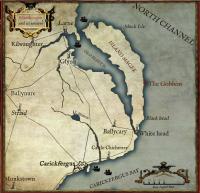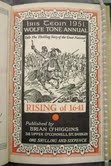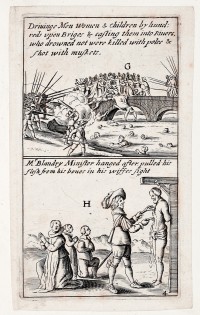‘What about Islandmagee?’ Another version of the 1641 rebellion
Published in 1641 Rebellion, 18th–19th - Century History, Confederate War and Cromwell, Cromwell, Early Modern History (1500–1700), Featured-Archive-Post, Features, General, Issue 1(Jan/Feb 2013), Volume 21
The 1641 rebellion has attracted a good deal of attention in recent years thanks to the online release of the ‘1641 Depositions’, collected from Protestant survivors in the aftermath. But as John Gibney explains, Irish Catholics had their own views on what had happened in 1641.
When agents of the Irish Ordnance Survey arrived at the small peninsula of Islandmagee in Co. Antrim in 1840, to collect information for the memoirs that were to accompany the survey, they took the view that one of ‘the only remarkable events of which there is either local record or tradition as to their having occurred in this parish’ was ‘the alleged massacre of the Roman Catholics by a part of the Protestant garrison of Carrickfergus on the 8th of January 1641 [1642]’. The collectors noted that Islandmagee was a woodless but fertile place, less than eight miles long and two miles wide, and overwhelmingly populated by Presbyterians, who made up two thirds of the inhabitants of the peninsula (1727 out of 2549). On the other land, there were only 46 Catholics: less than 2% of the total. A cynic might assume that the Catholics of Islandmagee were outnumbered in the present because they had been victims in the past.
The 1641 rebellion and its legacy
The rebellion broke out in October 1641 when members of the Catholic nobility seized key positions in Armagh and Tyrone. They did so to strengthen their hand in prospective negotiations with the king, Charles I, on issues relating to their rights as landowners, and as Catholics. But this prompted a popular uprising aimed at Protestants who had settled in Ireland during the plantation of Ulster. The assumption that thousands of those Protestants were slaughtered helped to secure English support for the reconquest of Ireland in 1649; one justification used by Oliver Cromwell was that the massacres of 1641 had yet to be avenged. After the restoration of the monarchy, the 1662 Act of Settlement largely confirmed the Cromwellian land confiscations on the grounds that 1641 witnessed ‘a formed and almost national rebellion of the Irish papists…to the destruction of the English and Protestants inhabiting in Ireland’. Fears of a repeat of 1641 flared up again in the reign of James II (1685-88), and were later invoked as a justification for the anti-Catholic Penal Laws. As one Dublin preacher told his congregation on 23 October 1735 (the anniversary of the rebellion), the Penal Laws ‘are only to be justified on the grounds of civil self-defence’; presumably, against any future repeat of 1641.
Which massacre mattered?
In 1653 the Cromwellian authorities collected a number of testimonies – ‘depositions’ – that referred to killings at Islandmagee during the 1641 rebellion. Some deponents mentioned specific victims by name; others, how they had heard that these ‘massacres’ were carried out by Scotsmen from the vicinity of Ballymena. Hearsay was not the same as proof, but what made these allegations distinctive was not the issue of what had happened; it was the issue of who it had happened to. The 1641 rebellion was usually depicted as a brutal sectarian massacre, perpetrated by Irish Catholics upon the British Protestant settlers who had supplanted them. But the allegation of a very different massacre at Islandmagee turned this image on its head; and just as images of the sufferings of Protestants at places like Portadown in 1641 had a lurid and sensational afterlife, the image of Catholics being slaughtered at Islandmagee went on to have an equally emotive career.
The alleged massacre at Islandmagee first appeared in print after the restoration of Charles II in the early 1660s, in a tract authored by an anonymous ‘R.S.’ This was apparently a royalist soldier who was outraged at the way in which he and others remained in the ranks of the dispossessed after 1660, especially as former Cromwellians had profited despite their disloyalty. The continual reaffirmation of a ‘Protestant’ version of 1641 was, in his view, ‘for no other end then to render all the Catholics there (in all good men’s opinions) blasted and unfit to partake of his Majesties grace and favour’.
His pamphlet was, for the most part, a reasonably sober account of various atrocities committed against Catholics by Protestant’s and, later, by parliamentarian forces. Its emphasis was obvious. But its introduction offered something by way of interpretation. It ridiculed the numbers of Protestants allegedly killed in 1641 on the reasonable grounds that the usual figures bandied around far exceeded the Protestant population of Ireland. It disputed the evidence of massacres as collected by the authorities (the infamous ‘1641 depositions’). Finally, it claimed quite bluntly that Catholics had been attacked first; any attacks on Protestants during the ‘rebellion’ were done by way of retaliation, and the first of these attacks on Catholics had taken place at Islandmagee.
‘About the beginning of November, the English and Scots forces in [Carrickfergus] murdered in one night, all the inhabitants of the territory of Islandmagee to the number of above 3,000 men women and children, all innocent persons, in a time when none of the Catholics of that county were in arms or [in] rebellion. Note that this was the first massacre committed in Ireland of either side’.
The allegation had a very pointed relevance. In the early 1660s, the assumption that 1641 had witnessed a wholesale Catholic massacre of Protestants was used as a reason not to undo the dispossession of Catholic landowners undertaken by the Cromwellian regime; any allegation that Catholics did not the first blow was bound to be controversial. Many Protestant leaders poured scorn on such notions. Catholic polemicists, on the other hand, naturally defended them, and in 1695 the Jacobite Hugh Reily summed up the Catholic perspective on the 1641 rebellion in a single sentence: ‘I think it very plain, that the Protestants were the first actors on the stage’.
1641 and the ‘Catholic Question’
There was a straightforward logic to these claims and counter claims, one that became even more relevant in the eighteenth-century. If the Protestant version of 1641 was correct, and Irish Catholics had indeed tried to exterminate their Protestant neighbours, than Protestant Ireland was perfectly entitled to defend itself by maintaining the dispossesson of Catholics and, as time wore on, by officially disenfranchising them from a wide range of economic and political rights via the ‘popery’ or ‘penal’ laws. But this is precisely what gave the disputed massacre at Islandmagee an enduring relevance. In the 1740s the Catholic physician John Curry began to publish a sequence of works that made up a formidable attempt at articulating a Catholic perspective on Irish history in general, and 1641 in particular. Within this, Islandmagee loomed large. Curry went to great lengths to demonstrate that 3,000 Catholic men, women and children had been massacred by English and Scots forces in and around Carrickfergus and Islandmagee in November 1641. The depositions that did mention killings at Islandmagee claimed that they happened in January 1642, but Curry sought to discredit these (along with virtually anything else that seemed to contradict his argument). Timing was fundamental to his case. If Islandmagee had witnessed the first blow struck by any side in the winter of 1641, then Curry could – and did – argue that Catholic attacks on Protestants were simply retaliation. What was by now the official ‘Protestant’ version of 1641 had, he argued, been cynically used to blacken the name of the Catholic Irish, and thereby justify their dispossession.
The context in which Curry wrote was straightforward enough. To dismiss the allegations of a massacre of Protestants was to provide a further weapon in the ongoing debate over whether or not to repeal the Penal Laws: the ‘Catholic Question’. Should a Catholic interpretation of 1641 successfully prevail over the Protestant one, then a key historical justification for the existence of a sectarian state in eighteenth-century Ireland would be undermined. The argument over Islandmagee was essentially a debate about who were the real victims of 1641, and the argument reappeared as the century wore on, debated at length or simply regurgitated by a wide range of authers. How many were killed? When were they killed? Who was killed first? And so on, ad nauseum.
‘Ireland Vindicated’
John Curry was not the only writer to try to dismiss the Protestant version of 1641. The Dublin born printer Mathew Carey published his mammoth Vindiciae Hibernicae in Philadelphia in 1819, using Protestant authors against themselves to show that their version of 1641 was a ‘foul, bloated mass of fraud and perjury’. Even Daniel O’Connell got in on the act. His Memoir on Ireland native and Saxon (1843) was a sweeping summary of Irish history – and English misrule – aimed at an English audience. When discussing 1641, O’Connell pulled no punches: ‘There were two objects to be gratified by the English Protestant rulers of the day. The first was the increase of plunder to themselves in the confiscation of the estates of the Catholics. The second was the indiscriminate slaughter of those Catholics, without any distinction of age, sex, rank, or condition’. But the English ‘carried their malignity further; and they accused the Irish of those very crimes which they themselves committed upon that unhappy people…and the Catholics of Ireland for more than a century were persecuted to the loss of their lives and properties; and (what was still more grievous and afflicting) by the loss of their reputation for that conduct, which, while it really merited the applause of all good men, was converted into the imputation of foul and horrible slaughter’.
Fiction and ‘tradition’
As the ‘Catholic Question’ was eventually resolved, the massacre at Islandmagee changed from being an event with relevance to contemporary concerns. It now became a cornerstone of a version of Irish history underpinning an emergent sense of Catholic, nationalist identity. Islandmagee in 1641 could be taken as certain proof that Irish Catholics were historically the losers, the oppressed and the victimised. This guaranteed that the Catholic account of the massacre was taken as gospel by writers in a variety of genres. For example, The Confederate Chieftains (1865), a romantic novel by the prolific Cavan born émigré ‘Mrs J. Sadlier’ (née Mary Anne Madden) was set in the 1640s and was written to bring Irish history to life in order to ‘ennoble our country and give her that place amongst the nations to which the glory of her sons entitles her’. 1641 was cast as a preemptive strike against rumours that the Scots were planning to massacre the Catholic Irish, which is precisely what they did at Islandmagee. There they bayoneted an old woman in the throat with ‘shouts of fiendish laughter’, and as they did so, ‘of all the gallant chieftains who were then in arms with their legions of brave followers, to repel the aggressions of bigotry and legalized rapine, not one was near in that dark hour to save the unoffending peasantry of Island Magee from the exterminating sword of fanatical ruffians…they were far, far away, little dreaming of the foul butchery which, on that night, commenced the work of slaughter in the northern province’. The implication was obvious.
 But nineteenth century accounts of Islandmagee and its history often made reference to ‘tradition’; and this is precisely what the Ordnance Survey had encountered when they got there. They were told that the massacre was carried out by Scottish troops in retaliation for the ‘horrible butcheries’ of Protestants in neighbouring parishes. Consequently between forty and fifty Catholics were killed: one child was supposedly ‘stabbed in its mothers arms’. The collectors knew the inflammatory implications of what was alleged to have happened there, and were themselves wary of asking about the events of the 1640s, ‘lest it looks like a party question’. But tradition on the ground possessed nuances that were absent from the versions of Islandmagee massacre that usually appeared in print. The surveyors heard how some Catholics were saved by a Protestant called Hill (the surname of the local landlords in 1641). Afterwards, a ship owned by this Hill and manned by his relatives put into Westport, where the crew was treated with great courtesy thanks to the aid he gave to Catholics during the ‘massacre of 1641’. The overwhelmingly Presbyterian population of Islandmagee had over 180 members of the United Irishmen in 1798: might that have influenced such an ecumenical tale?
But nineteenth century accounts of Islandmagee and its history often made reference to ‘tradition’; and this is precisely what the Ordnance Survey had encountered when they got there. They were told that the massacre was carried out by Scottish troops in retaliation for the ‘horrible butcheries’ of Protestants in neighbouring parishes. Consequently between forty and fifty Catholics were killed: one child was supposedly ‘stabbed in its mothers arms’. The collectors knew the inflammatory implications of what was alleged to have happened there, and were themselves wary of asking about the events of the 1640s, ‘lest it looks like a party question’. But tradition on the ground possessed nuances that were absent from the versions of Islandmagee massacre that usually appeared in print. The surveyors heard how some Catholics were saved by a Protestant called Hill (the surname of the local landlords in 1641). Afterwards, a ship owned by this Hill and manned by his relatives put into Westport, where the crew was treated with great courtesy thanks to the aid he gave to Catholics during the ‘massacre of 1641’. The overwhelmingly Presbyterian population of Islandmagee had over 180 members of the United Irishmen in 1798: might that have influenced such an ecumenical tale?
Yet with the passage of time this harmonious story may have been the exception rather than the rule. In the 1970s the Canadian historian Donald Akenson wrote a history of Islandmagee in the nineteenth century, and was struck by the persistence of folklore relating to a massacre of Catholics within this overwhelmingly Presbyterian community. He mischieviously concluded that ‘something else was at play, keeping the tale alive. The anti-Catholicism of an impacted Protestant community must have been contributory. And in a more general sense, the instinctive exclusiveness of an isolated parish was involved: the cleansing of the community of alien elements left a pure community. A tiny, rural herrenvolk myth had been established’.
A conclusion?
The uses to which the disputed events of 1641 were put twisted and turned with time, in a manner far removed from what may or may not have actually happened. This is usually noted in relation to the ‘Protestant’ version of 1641, but the same was true of its ‘Catholic’ equivalent. As for what really happened in Islandmagee, the collectors for the Ordnance Survey declined to answer what was almost certainly an impossible question; they simply confined themselves to noting how the death tolls had ranged from 6 to 3,000, ‘at which the humanity of historians has allowed them to remain’.
John Gibney is History Ireland news editor
Further reading:
1641 depositions: online at http://1641.tcd.ie/
John Gibney, The shadow of a year: the 1641 rebellion in Irish history and memory (Madison, WI, 2013).

















